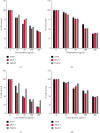In Vitro Antioxidant, Cytotoxic Activities, and Phenolic Profile of Senecio glaucus from Saudi Arabia
- PMID: 33163085
- PMCID: PMC7604592
- DOI: 10.1155/2020/8875430
In Vitro Antioxidant, Cytotoxic Activities, and Phenolic Profile of Senecio glaucus from Saudi Arabia
Abstract
Current treatments for complex diseases have remarkable side effects that negatively impact patients' quality of life. Thus, natural compounds with fewer side effects represent a promising source for safe drugs. The genus Senecio is widely used in folk medicine due to its various pharmacological properties. In the present study, the total phenolic content of Senecio glaucus, which is grown in Saudi Arabia, was assessed using the Folin-Ciocalteau colorimetric method. Scavenging DPPH and ABTS assays were utilized to determine the antioxidant properties of S. glaucus fractions, and MTT assay was used to screen the cytotoxic activity of S. glaucus against various cancer cells. In addition, HPLC-UV was utilized to detect the presence of two phenolic acids, namely, vanillic acid (VA) and gallic acid (GA). Among all fractions tested, S. glaucus chloroform fraction (SGCF) yielded the highest value (125.3 mg·GA/g) in terms of total phenolic content. SGCF also exhibited the highest scavenging activities (76.7 and 74.1%) on both DPPH and ABTS assays, respectively. Similarly, SGCF also possessed the most potent cytotoxic activity against the MCF-7 cell line, with an IC50 value of 41.8 μg/ml. The validated HPLC method confirmed the presence of VA (4.8 μg/mg DW) and GA (3.9 μg/mg DW) in SGCF. Overall, our data show that S. glaucus had antioxidant and cytotoxic properties. A developed validated HPLC method which could be helpful for quantifying phenolic compounds in S. glaucus was established.
Copyright © 2020 Ali S. Alqahtani et al.
Conflict of interest statement
The authors declare that there are no conflicts of interest.
Figures




Similar articles
-
Antioxidant and Cytotoxic Effect of Barringtonia racemosa and Hibiscus sabdariffa Fruit Extracts in MCF-7 Human Breast Cancer Cell Line.Pharmacognosy Res. 2016 Jan-Mar;8(1):66-70. doi: 10.4103/0974-8490.171104. Pharmacognosy Res. 2016. PMID: 26941539 Free PMC article.
-
A comparative study on phenolic components and biological activity of some Senecio species in Turkey.J Pharm Pharmacol. 2014 Nov;66(11):1631-40. doi: 10.1111/jphp.12288. Epub 2014 Jun 19. J Pharm Pharmacol. 2014. PMID: 24945637
-
Measurement of total phenolic content and antioxidant activity of aerial parts of medicinal plant Coronopus didymus.Asian Pac J Trop Med. 2017 Aug;10(8):792-801. doi: 10.1016/j.apjtm.2017.07.024. Epub 2017 Aug 19. Asian Pac J Trop Med. 2017. PMID: 28942828
-
Optimization of Ultrasonic-Assisted Enzymatic Extraction Conditions for Improving Total Phenolic Content, Antioxidant and Antitumor Activities In Vitro from Trapa quadrispinosa Roxb. Residues.Molecules. 2017 Mar 6;22(3):396. doi: 10.3390/molecules22030396. Molecules. 2017. PMID: 28272313 Free PMC article.
-
Phytochemical profiling, antioxidant and anticancer activities of Gastrocotyle hispida growing in Saudi Arabia.Acta Trop. 2019 Mar;191:243-247. doi: 10.1016/j.actatropica.2019.01.013. Epub 2019 Jan 16. Acta Trop. 2019. PMID: 30659804
Cited by
-
Insecticidal Activity and Free Radical Scavenging Properties of Isolated Phytoconstituents from the Saudi Plant Nuxia oppositifolia (Hochst.).Molecules. 2021 Feb 9;26(4):914. doi: 10.3390/molecules26040914. Molecules. 2021. PMID: 33572261 Free PMC article.
-
Comment on Pyrrolizidine Alkaloids and Terpenes from Senecio (Asteraceae): Chemistry and Research Gaps in Africa.Molecules. 2022 Dec 13;27(24):8868. doi: 10.3390/molecules27248868. Molecules. 2022. PMID: 36558004 Free PMC article.
References
-
- Minatel I. O., Borges C. V., Ferreira M. I., et al. Phenolic Compounds Biological Activity. 1. Rijeka, Croatia: InTech; 2017. Phenolic compounds: functional properties, impact of processing and bioavailability; pp. 1–24.
LinkOut - more resources
Full Text Sources

